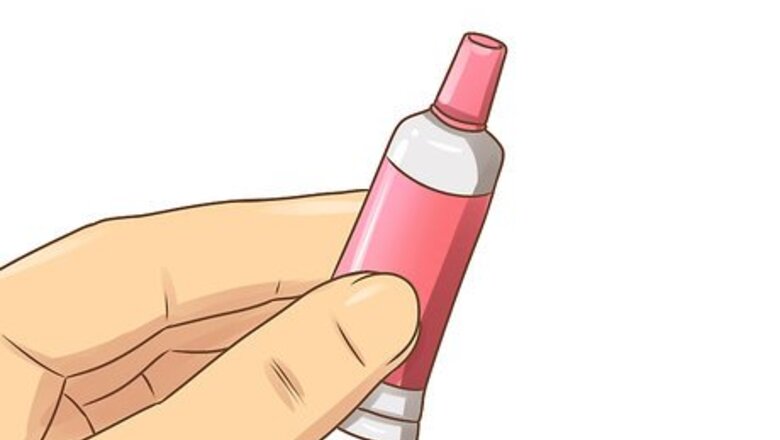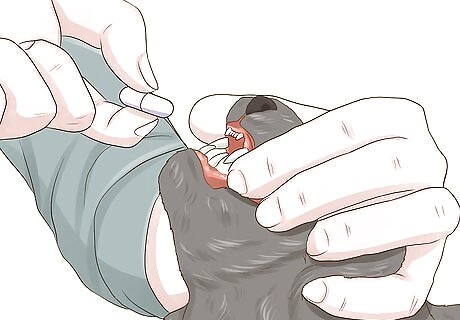
views
Choosing a Specific Type of Product

Use topical preventative to repel fleas. Many types of topical preventatives act as a flea repellent. This protects your pet by repelling fleas and ticks from them. It keeps them off your pet in the first place. Oral preventatives do not offer any repelling properties. An oral preventative only works if the flea bites the animal or is on the pet.

Choose an oral preventative for convenience. Oral medications are often chosen due to their convenience. With an oral preventative, you don’t have to worry about a drying period where the pesticide can transfer to children or other pets. Once the pet swallows the medication, you are finished. Some oral preventatives only kill the eggs or adult fleas, but not both. You may need an additional preventative if your oral tablet only focuses on one threat. Be aware that your pet may refuse to swallow the oral medication or may spit it out after you place it in their mouth. Even if you place it in their food, they may eat around it. Some brands of oral preventatives come in flavored chewable tablets, like beef flavored.

Try a collar. Collars are a different kind of topical preventative. Collars are easy to use because you put them on your pet and they are protected. Most collars kill and repel fleas. With collars, you have to make sure no one touches the collar, especially children, since it contains the chemical preventative. Collars may be less effective for fleas because fleas generally live close to the bottom of the body, around the rear area, instead of near the head where the collar will be. Collars may have a strong, unpleasant odor. They may also irritate your pet’s neck or skin.

Think about other types of topical products. You may be interested in other types of topical preventatives, such as sprays, powders, and shampoos. Sprays, powders, and shampoos work immediately to kill fleas, but they do not protect your pet from reinfestation and do not repel fleas. Powders generally last for about a week and shampoos last for a day. Sprays generally last for up to a month, but your pet cannot get wet. This includes swimming, baths, or rain. If you want ongoing protection from fleas, consider something stronger than these products.

Talk to your vet. If you are not sure what kind of flea preventative to give your pet, talk to your vet. Flea preventatives are a type of medication, which means if your pet already takes medication or has existing health issues, the preventative may interfere. Discuss which type and brand of preventative will be best for your pet with the veterinarian before choosing one. The age, breed, and species of your pet may also influence what you give your pet.
Considering Your Pet’s Situation

Decide if you want a prescription medication. Many topical and oral flea preventatives are available only with a prescription from your vet. Some professionals believe these are more effective and safer than buying over-the-counter medication. Most oral preventatives require a prescription, while many topical preventatives can be purchased without one. If you need to take your pet to the vet, you can discuss getting a prescription preventative during a regular visit. You may be able to call your vet and ask for a prescription without taking your pet in. If you don’t want to go through a vet, you may want to choose an over-the-counter method.

Determine if you want a preventative that protects against more than fleas. Many preventatives that protect against fleas also protect against ticks, mosquitoes, and heart disease. These multi-preventatives can be found in oral and topical preventatives. Determine what you want to protect your pet against. For example, you may not need a tick preventative, but you may need a heartworm preventative instead. Talk to your vet if you are unsure what you should protect your pet from.

Think about the best choice if you have small children. If you have small children in the house, you may consider whether or not you can safely allow a topical product to dry. If your children touch any topical preventatives that have not finished drying, there is a pesticide risk. If you follow the directions on the label and allow the topical flea preventative to dry, your children should be safe. If you feel uncomfortable with the potential risk, give your pet oral preventatives.

Consider which type is appropriate if you own multiple pets. Having multiple pets may also be another concern when you are trying to decide between an oral and topical preventative. If you use a topical preventative, make sure that your pets don’t lick, groom, or play with each other until the preventative is dry. As long as you let the topical preventative dry on each pet before they play, lick, or touch each other, using a topical preventative should not be a problem. You may want to keep your pets in different rooms until the preventative dries. You can also keep them in separate kennels or place some pets outside. You can use oral preventatives to reduce any risk of this problem.

Use caution with topical preventatives if you have a cat. There are many topical flea preventatives marketed for dogs. You shouldn’t use these topical products on cats unless they are safe and designed to be used on cats. Using canine preventatives on a cat can cause serious health issues or even death. If you have both dogs and cats, use caution with topical canine preventatives around your cat. If you use a spot-on treatment, make sure that your dog is completely dry before it interacts with your cat.
Addressing Potential Risks

Notice any topical skin reactions. Your pet may experience a skin reaction if you use a topical preventative. This reaction may cause skin irritation, redness, a rash, or even hair loss. If your pet experiences this, you should switch to an oral preventative. This type of reaction is not common.

Check for any digestive issues. An oral preventative may cause problems with your pet’s digestive tract. Your pet may have a sensitivity to the oral medication, an upset stomach, or other digestive issues. If your pet experiences this, switch to a topical medication. You should give the oral preventative with a meal. This helps reduce the risk of digestive problems. Digestive problems are not common.

Bathe your pet gently if using topical preventatives. Once it dries, topical preventatives protect your pet's entire body. They can get wet, swim, and be bathed. However, when you bathe your pet, you should use gentle shampoos. This helps reduce the likelihood that the shampoo will strip the skin, and therefore, the medication. Look for gentle or sensitive skin shampoos for your pet. Refrain from anything that is maximum strength or strong.



















Comments
0 comment